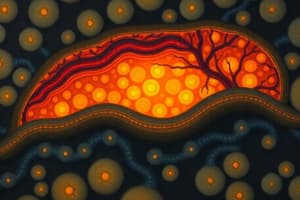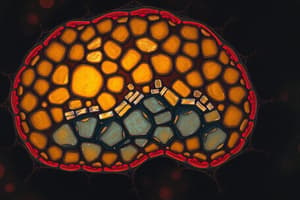Podcast
Questions and Answers
Which cellular components are considered part of the endomembrane system?
Which cellular components are considered part of the endomembrane system?
- Mitochondria, chloroplasts, and peroxisomes
- Cell wall, extracellular matrix, and cytoskeleton
- Endoplasmic reticulum, Golgi apparatus, and lysosomes (correct)
- Cytosol, nucleolus, and ribosomes
What is the primary structural difference between the rough ER (RER) and smooth ER (SER)?
What is the primary structural difference between the rough ER (RER) and smooth ER (SER)?
- RER is continuous with the cell membrane, while SER is continuous with the nuclear membrane.
- RER consists of tubular structures, while SER consists of flattened sacs.
- RER contains a lumen with a composition identical to the cytosol, while SER's lumen differs significantly.
- RER has ribosomes attached to its surface, while SER does not. (correct)
If a cell is actively involved in synthesizing steroid hormones, which organelle would likely be most abundant?
If a cell is actively involved in synthesizing steroid hormones, which organelle would likely be most abundant?
- Lysosomes
- Golgi Apparatus
- Smooth Endoplasmic Reticulum (SER) (correct)
- Rough Endoplasmic Reticulum (RER)
Which of the following is a function primarily associated with the smooth endoplasmic reticulum (SER)?
Which of the following is a function primarily associated with the smooth endoplasmic reticulum (SER)?
How do the enzymes required for steroid hormone synthesis get to the Smooth Endoplasmic Reticulum (SER)?
How do the enzymes required for steroid hormone synthesis get to the Smooth Endoplasmic Reticulum (SER)?
How does the rough endoplasmic reticulum (RER) contribute to the function of the endomembrane system?
How does the rough endoplasmic reticulum (RER) contribute to the function of the endomembrane system?
Which of the following best describes the relationship between the rough endoplasmic reticulum (RER) and the nuclear membrane?
Which of the following best describes the relationship between the rough endoplasmic reticulum (RER) and the nuclear membrane?
In skeletal muscle cells, the smooth endoplasmic reticulum (SER) is specialized and known as the sarcoplasmic reticulum. What is its primary function in these cells?
In skeletal muscle cells, the smooth endoplasmic reticulum (SER) is specialized and known as the sarcoplasmic reticulum. What is its primary function in these cells?
Which of the following is the primary function of oxygenase enzymes, particularly cytochromes P450, within the Smooth Endoplasmic Reticulum (SER)?
Which of the following is the primary function of oxygenase enzymes, particularly cytochromes P450, within the Smooth Endoplasmic Reticulum (SER)?
In hepatocytes, what is the role of glucose 6-phosphatase, an enzyme found in the SER membrane, during periods of low blood sugar?
In hepatocytes, what is the role of glucose 6-phosphatase, an enzyme found in the SER membrane, during periods of low blood sugar?
How does the SER contribute to muscle contraction?
How does the SER contribute to muscle contraction?
What distinguishes proteins synthesized by ribosomes bound to the RER from those synthesized by free ribosomes in the cytosol?
What distinguishes proteins synthesized by ribosomes bound to the RER from those synthesized by free ribosomes in the cytosol?
How does the signal recognition particle (SRP) facilitate the insertion of a growing polypeptide into the RER lumen?
How does the signal recognition particle (SRP) facilitate the insertion of a growing polypeptide into the RER lumen?
During N-glycosylation, where and to which amino acid is the oligosaccharide chain attached?
During N-glycosylation, where and to which amino acid is the oligosaccharide chain attached?
What role does dolichol play in the glycosylation of proteins within the RER?
What role does dolichol play in the glycosylation of proteins within the RER?
How do proteins with hydrophobic alpha-helices become integral membrane proteins of the RER?
How do proteins with hydrophobic alpha-helices become integral membrane proteins of the RER?
What is the primary role of the region of the RER that is devoid of ribosomes and located near the cis-Golgi network?
What is the primary role of the region of the RER that is devoid of ribosomes and located near the cis-Golgi network?
What is the purpose of retrograde movement of vesicles from the Golgi apparatus back to the RER?
What is the purpose of retrograde movement of vesicles from the Golgi apparatus back to the RER?
Flashcards
Endomembrane System
Endomembrane System
A network of membranous organelles including the ER, Golgi, endosomes, lysosomes, nuclear membranes, and vacuoles that work together.
Endomembrane Functions
Endomembrane Functions
Synthesis and maturation of molecules, sorting, targeting, packing and bulk transport.
ER
ER
The endoplasmic reticulum, which is divided into two types: Rough ER and Smooth ER.
Rough ER (RER)
Rough ER (RER)
Signup and view all the flashcards
Smooth ER (SER)
Smooth ER (SER)
Signup and view all the flashcards
Cells with active protein synthesis
Cells with active protein synthesis
Signup and view all the flashcards
Cells with active steroid synthesis
Cells with active steroid synthesis
Signup and view all the flashcards
Sarcoplasmic Reticulum
Sarcoplasmic Reticulum
Signup and view all the flashcards
Xenobiotics
Xenobiotics
Signup and view all the flashcards
Oxygenases
Oxygenases
Signup and view all the flashcards
Glucose-6-phosphatase
Glucose-6-phosphatase
Signup and view all the flashcards
SER Calcium Sequestration
SER Calcium Sequestration
Signup and view all the flashcards
Signal Recognition Particle (SRP)
Signal Recognition Particle (SRP)
Signup and view all the flashcards
Translocon
Translocon
Signup and view all the flashcards
Disulfide Isomerases
Disulfide Isomerases
Signup and view all the flashcards
Glycosylation
Glycosylation
Signup and view all the flashcards
Dolichol
Dolichol
Signup and view all the flashcards
Oligosaccharyl Transferase
Oligosaccharyl Transferase
Signup and view all the flashcards
Study Notes
- The endoplasmic reticulum (ER) is part of the endomembrane system, which is a group of membranous organelles within eukaryotic cells.
- The endomembrane system includes the ER, Golgi apparatus, endosomes, lysosomes, vacuoles, and nuclear membranes, all working together.
- Processes coordinated by the endomembrane system involve synthesis and maturation of carbohydrates, lipids, and proteins.
- The endomembrane system is involved in sorting, targeting, and packaging synthesized materials.
- The endomembrane system regulates bulk transport, endocytosis, exocytosis, and phagocytosis.
- The endomembrane system plays a role in intracellular digestion and processing.
- Mitochondria, chloroplasts, and peroxisomes are not part of the endomembrane system because their membranes function independently.
RER and SER Structures
- The ER consists of rough ER (RER) and smooth ER (SER), which are structurally and functionally distinct but physically connected.
- Both RER and SER are membranous systems that enclose a lumen, dividing the cytoplasm into the cytosol and the lumen.
- The lumen composition differs from the cytosol.
Rough ER
- RER has interconnected flattened sacs (cisternae) with ribosomes attached to the cytosolic face.
- The RER membrane is continuous with the outer nuclear membrane, which also has ribosomes on its cytosolic face.
Smooth ER
- SER consists of interconnected tubular structures without ribosomes.
SER/RER Ratio
- The amounts of SER and RER vary among cell types.
- Extensive RER is found in cells with active protein synthesis, such as pancreatic cells.
- Extensive SER is found in cells with active steroid synthesis, such as Leydig cells.
- Hepatocytes have similar amounts of RER and SER.
SER Functions
- SER is well-developed in skeletal muscle fibers, where it is called the sarcoplasmic reticulum.
- SER functions include steroid hormone and lipid synthesis, detoxification of xenobiotics, dephosphorylation of glucose 6-phosphate, and sequestering calcium ions.
Synthesis of Steroid Hormones and Lipids
- Steroid hormone synthesis occurs in endocrine cells and requires enzymes present in the SER membrane and lumen.
- Integral proteins in the SER membrane of hepatocytes produce HDL, LDL, and other lipids, such as phospholipids.
Detoxification of Xenobiotics
- Xenobiotics are foreign chemicals not synthesized by the organism.
- Detoxification of toxic substances occurs mainly in the liver, but other organs also contribute.
- Detoxification transforms hydrophobic chemicals into hydrophilic metabolites for elimination in urine or bile.
- Oxygen-transferring enzymes, such as cytochrome P450s in the SER, carry out detoxification.
Dephosphorylation of Glucose 6-Phosphate
- Hepatocytes store glucose as glycogen granules next to the SER.
- Low glycemia triggers the conversion of glycogen back into glucose.
- Glycogen is converted to glucose 6-phosphate, which remains in the cytoplasm.
- The SER membrane contains glucose 6-phosphatase, which dephosphorylates glucose 6-phosphate into glucose.
- Glucose is then transported out of the cell.
Sequestering Calcium Ions
- SER collects calcium ions inside the lumen and releases them upon stimulation.
- Calcium is collected via calcium-binding proteins within the SER.
- Regulated calcium release from the SER triggers muscle contraction.
RER Functions
- RER functions include protein synthesis by membrane-bound ribosomes, glycosylation of proteins, lipid biosynthesis and membrane proliferation, and export of vesicles to the Golgi apparatus.
Synthesis of Proteins by Membrane-Bound Ribosomes
- RER is the site of protein synthesis due to attached ribosomes.
- Secreted proteins and proteins of the endomembrane system are synthesized by these ribosomes.
- Other proteins are synthesized by free ribosomes.
- Proteins are exported to specific compartments after translation (post-translational delivery) based on their signal sequences.
Mechanism of Attachment and Polypeptide Insertion
- A signal sequence mediates protein attachment using the signal recognition particle (SRP).
- The translocon channel inserts the growing polypeptide into the RER lumen.
- The signal sequence is removed by signal peptidases.
- The SRP receptor is coupled to the translocon, where the ribosome binds.
- Proteins are released inside the lumen for maturation or retained in the lipid bilayer as integral proteins if they have hydrophobic helices.
- Disulfide isomerase catalyzes disulfide bridges in the polypeptide chain.
Glycosylation of Proteins and Maturation
- Glycosylation is the addition of sugar motifs to eukaryotic proteins, serving as molecular flags or recognition signals.
- Specific amino acids are branching points for oligosaccharides.
- N-glycosylation occurs on asparagine in the ER.
- O-glycosylation occurs on serine in the Golgi apparatus.
- Monosaccharides are joined to dolichol in the RER by glycosyl transferase, then transferred to a protein by oligosaccharyl transferase.
Biosynthesis of Lipids and Proliferation of Membranes
- This function is common to both RER and SER.
- Most membrane lipids are synthesized by integral proteins in the ER.
Export of Vesicles to Golgi Apparatus
- RER lumen and membrane components can move between cisternae.
- Maturing products move toward the cisterna near the cis Golgi network.
- Vesicles bud from the ribosome-depleted RER in this region and are delivered to the Golgi in anterograde movement.
- The RER also receives vesicles from the Golgi in retrograde movement to compensate for membrane loss.
Studying That Suits You
Use AI to generate personalized quizzes and flashcards to suit your learning preferences.
Description
Explore the endoplasmic reticulum (ER) as part of the eukaryotic endomembrane system, including the Golgi apparatus, endosomes, and lysosomes. Learn about the roles of RER and SER in protein synthesis, lipid metabolism, and transport. Understand the function of the endomembrane system.




